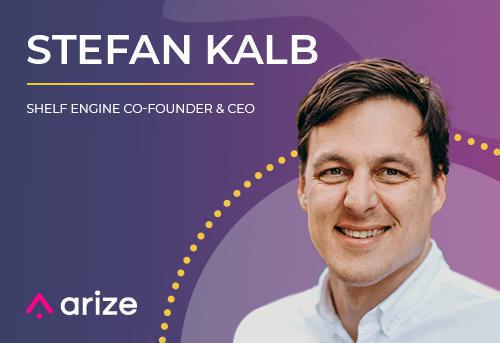
Shelf Engine CEO Stefan Kalb
Stefan Kalb is on a mission to eliminate food waste and revolutionize the grocery business. Shelf Engine – the company he co-founded and leads as CEO – has notched an impressive track record since its founding in 2016, diverting over 4.5 million pounds of food waste from landfills and helping some of the largest retail and foodservice brands in the world realize an average gross margin dollar expansion of more than 15%. Behind that success is an AI engine that predicts consumer demand with high precision and automates ordering for every SKU, every day, in every store. Shelf Engine first partnered with Arize AI to monitor and observe some of its machine learning (ML) models last year.
Arize: Can you briefly tell us about your background and why you founded Shelf Engine?
Kalb: My academic background is in actuarial science, and I actually had a brief stint early in my career predicting tornadoes in the insurance industry. Years ago, I started a company that offered high-end grab-and-go foods – growing the company for a decade to be a category leader in the Pacific Northwest and later seeing it through an acquisition.
In the process, I became fascinated with how grocery managers order, which seems niche but is actually a big part of our economy. What blew me away then and now was the tremendous amount of waste and the fact that most grocery managers basically order on pen and paper. How big is this problem? In the U.S., it’s about $1 trillion in purchasing a year by a fairly small number of people with very crude methodologies.
So I teamed up with a friend who had been at Microsoft for over a decade and attracted investors – at launch, we had Alexis Ohanian (via Initialized Capital) and Joe Montana (via Liquid 2 Ventures) – and set out to pursue this problem.
A lot of war stories later, Shelf Engine is now over five years old and has a team of over 200 people. We operate with a unique model. To potential grocery store clients, we say: we will manage your orders, and we will guarantee the results – so we are not a SaaS company, we are a company that will literally guarantee an outcome. Here’s how it works: we purchase on behalf of customers, pay the vendor for everything they deliver and only charge customers for what sells. For this service, we charge a fee for every item sold – however, that fee is always less than the waste a customer used to incur.
MORE FOR YOU
We are able to make a dramatic impact with customers like Kroger, Target and Whole Foods – grocers that have this problem at scale.
Arize: Shelf Engine works with grocers on an Results-as-a-Service (RaaS) basis, directly taking on inventory risk. Why did you choose this model and what has the reception been like?
Kalb: This results-as-a-service concept was coined at the same time that Shelf Engine was founded, and that’s not a coincidence – hopefully credit will be properly attributed when the history books are written.
When we originally came up with this model, investors thought we were crazy. SaaS is a nice, clean model – you’re not taking on risk – but I don’t think it’s a winning model. Today, a lot of people are starting to notice Shelf Engine’s model and wondering whether to imitate it for their own industry. I think they’re starting to see the impact of what it means to go to a customer and legitimately say, “We will guarantee the results.” You are able to execute so much better because you own the results, versus the old model of just handing someone a piece of software and saying good luck. We are making immense progress and demonstrating to the world that this is a dominant business model.
Arize: A recent survey of top grocers by Shelf Engine lists product availability, quality and consistency as the biggest concern facing grocers. Why do you think this is such a persistent problem?
Kalb: We have a special visibility on this problem because – and this is rare for a technology company – we actually have a field team that is distributed across the country that goes into our customers’ stores and facilities and collects data so we understand what’s happening at the ground level.
That’s partly why we are able to train our AI to be the best in the industry – we have very good visibility into what’s happening day-to-day with our vendors. The reality is that the country is in crisis right now. The supply chain on the food side is more dramatically impacted than anyone fully realizes, and it has reached a point where some of the major production facilities just can’t produce. Some days, they will only be at 60 or 70% of capacity; others, they will have an entire product line where they are four or five months away from getting needed packaging. These are just a few examples; it changes every day.
It’s fascinating to put these problems in the context of what Shelf Engine is doing. Since we’re ordering the product, when you magically all of a sudden don’t have 30-40% of the product that was supposed to show up, the way you adjust orders forward is very complex. Because we have AI doing it, we are in a good position; when it’s just humans, adjusting the next forward order is difficult. We recognize that retailers want to see the availability and quality of the product and it’s obviously something that vendors can’t meet right now given global conditions, so we’re doing our best to make a meaningful impact for them in this fast-moving and constantly changing situation.
Arize: Shelf Engine offers disruptive innovation without disruptive adoption. What do you mean by this and how does this benefit your customers?
Kalb: Here’s a quick history of technology in retail: 30 years ago, when it started making sense to introduce technology into retail processes, a lot of B2B technology companies installed big hardware systems at grocers. Installations were really complicated and involved moving servers into each and every store – today, you can still walk into most grocery stores and they will literally have a server room on-site.
Today, a lot of the software companies and systems – ERPs – catering to retailers still function like that. A lot of vendors will try to sell an ordering system or other product for upwards of $2 million per year that has a two-year implementation before being rolled out fully. If you’re an executive at a grocery store and you have a problem today that you want to solve and the software company tells you it starts today but it won’t be activated until two years from now – that’s a real problem!
When Shelf Engine set out to address this – and I had firsthand knowledge of this problem from my last company – I set a goal for our team to have clients up and running in two to four weeks. That’s exactly what we do today. If you’re an executive at a grocery store and your margins are suffering or you are seeing a ton of waste and you want to see an impact right away, we can do that.
Instead of installing technology on-premise, we say all we need is a couple of your data pipes – it literally takes an hour or two from IT folks to configure what we need. We just integrate with your data pipes and we’re good to go. This is unheard of but puts us at a huge advantage because when I walk into a store and talk to an executive and tell them I can grow their margins, they say prove it and we can in four weeks time.
A lot of companies are moving in the direction of the cloud and easy-to-install solutions, and it’s the right move – I don’t ever want to tell a customer that it will take two years to go live!
Arize: Another statistic Shelf Engine released is around shrink discrepancies, which occur more than 75% of the time for large and small grocers. What does that mean and why is it significant?
Kalb: When you look at national reports about how much food waste exists in the U.S., they’re wrong – it’s actually a lot worse. When we first launched Shelf Engine, I started going around and asking stores what their waste numbers were. Once we started getting our first customers and the data started flowing in, I realized most of their waste estimates were wrong. When an executive tells me they have 5% waste and we look at the data and there is 20% waste, something is clearly broken. The most egregious offense: one grocer’s senior executive told me their waste in produce was 12% – at launch, we discovered their waste was 54% and they were literally wasting more produce than they were selling.
There are a few reasons this happens. The first is that most stores “scan out” waste – which means they scan out a product before throwing it away. However, often a lot of waste goes into the bin and never gets counted. When an executive looks at the waste report, it says 12% and they assume it’s correct – but the reality is that’s only scanned data. This is very common. It’s difficult to reconcile with the fact that we’re talking about multi-billion-dollar, publicly-traded companies but it’s true.
Another reason this happens is because it’s not as simple as taking the sales data and order data from vendors and looking at the delta between those two to calculate waste. The problem for a lot of grocers is that data lives in two areas and it’s difficult to combine it; so what they have instead is receiving data, which they try to match up with vendor data, sold data, and other sources and it doesn’t match up properly – so they end up relying on scan-out waste data.
Most grocers don’t know how bad of a shrink problem they have. So in essence, the world doesn’t know how bad of a food waste problem that we actually have.
We discover this on nearly every account. We literally prepare our salespeople for meetings where an executive will tell you a waste number, but it’s actually going to be much higher – so you want to warn executives so they are not surprised in front of their team during an account review.
Arize: In the wake of COVID-19, a variety of shocks – from inflation to supply shocks and rapidly-evolving consumer behavior – continue to upend businesses. How are you helping customers adapt?
Kalb: The most intense time for a food retailer used to be Thanksgiving – executives and managers would prepare months ahead of time with inventory and hiring. When COVID-19 hit, it was the equivalent of Thanksgiving every single day for two weeks straight – it basically destroyed any of the systems retailers had built and put them in a position of playing nonstop defense where they couldn’t do anything but call their vendors and say, “Deliver everything you can.”
This has happened several times now since the onset of COVID-19 and ebbs and flows. One clear takeaway: given the massive labor shortage, this is the right time to embrace a different strategy for ordering. Not only can the AI do it far better than a human can, but we are in a position today where hours-worked are so precious and it’s so hard to come by labor that you need to find the tasks that you can pull off the team.
One of the biggest reasons we’re experiencing such dramatic growth with our customers is that they don’t have to rely on their labor for ordering anymore – they can turn on a switch, and we’re taking over orders very quickly. There are a lot of other technical ways that Shelf Engine adds value that are meaningful, but if you look at the true decision-making from our customers right now it’s how we’re relieving this massive pressure that they have on labor – some stores can’t even open currently because they don’t have staff.
Arize: Intelligent forecasting and order automation are difficult tasks to do well. How are AI and machine learning models helping Shelf Engine succeed where others failed?
Kalb: Many people ask why this hasn’t been solved and why is this so difficult. There are three parts to this that are important to understand. The first is that it’s not as easy as writing some math on a chalkboard and saying, “Let’s implement that.” There are tremendous complexities just with the data flows that come in, and it’s always an imperfect system – therefore the AI has to deal with numerous challenging edge cases. You have to create a really intelligent system for a staggering number of scenarios rather than just saying, “Hey, can you predict how many loaves of bread are going to sell on Wednesday?” It’s very complex.
The second answer is that you need highly capable people to do this – not just data scientists, but also engineers. If you look at well-built AI, there’s a spectrum between highly qualified engineers who can build these scalable systems to do massive computations very quickly all the way to these brilliant data scientists who are true mathematicians who really understand these models really well and a spectrum in between – such as data scientists who are also engineers who can put everything together. To say that you can create a world-class AI team by hiring a few data scientists is like saying you can win a Super Bowl with only three good linebackers.
What Shelf Engine has accomplished, and it’s taken a long time, is to bring together a team to build cutting-edge AI – and we only focus on this. Some other software companies that say they do all of these different things including forecasting with only two data scientists when we have a team of over 200 that builds AI makes the contrast clear to customers.
The third answer that is important to understand is that Shelf Engine has a big advantage in terms of our data. Some of the basic data that you would imagine we use – store sales, how much product was delivered, weather, school schedules, etc. – is there, but often the data that matters more is what we capture in stores and vendors. As mentioned, our field team goes into the stores on a periodic basis and captures all of this data – such as how well FIFO (first in; first out) is practiced in the store, how smooth is receiving, are they getting shorted, is there a lot of theft, is there a lot of breakage, are they adhering to the planograms and all these different inputs – and our AI is trained to such a place that I can tell you how good a given grocery store is performing at specific tasks compared to the same grocery store a mile away. That’s going to change how the ordering is going to happen for each one of those stores. For example, if FIFO is done improperly, it radically changes the ordering strategy at the store. Shelf Engine gathers that kind of data, which gives us a huge advantage.
Arize: What’s ahead for Shelf Engine this year?
Kalb: For us, scale is the next phase. We’ve proven that we can radically reduce waste. Although we’re already working with some of the biggest logos in the world, now the imperative is to work with everyone. To do so, we need to scale our technology. We need to get to that place where we can scale one thousand times and to be sustainable on that front. It’s an exciting time for the future of the industry and Shelf Engine is well-positioned to help retailers capture outsized growth.







